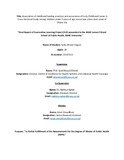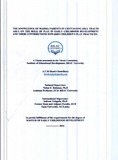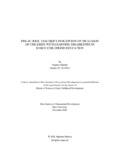| dc.contributor.advisor | Ahmed, Syed Masud | |
| dc.contributor.advisor | Naher, Nahitun | |
| dc.contributor.author | Association of childhood feeding practices and occurrence of Early Childhood Caries: A Cross Sectional Study among children under 5 years of age across two urban slum areas of | |
| dc.date.accessioned | 2023-07-18T10:03:56Z | |
| dc.date.available | 2023-07-18T10:03:56Z | |
| dc.date.copyright | 2023 | |
| dc.date.issued | 2023 | |
| dc.identifier.other | ID 22167013 | |
| dc.identifier.uri | http://hdl.handle.net/10361/18901 | |
| dc.description | This project report is submitted in partial fulfillment of the requirements for the degree of Master of Public Health (MPH), 2023. | en_US |
| dc.description | Cataloged from the PDF version of the project report. | |
| dc.description | Includes bibliographical references (pages 23-24). | |
| dc.description.abstract | Introduction
Early Childhood Caries (ECC) is the occurrence of a carious lesion in a primary tooth in children
less than 71 months. It is a significant dental problem that has negative effects on the growth
and development of children affected. The objective of this study was to explore the association
between early childhood feeding practices and the occurrence of dental caries in children under
the age of 5 living in the selected slums of Dhaka city.
Method
ECC and risk factors were examined using data from 402 children (between ages of 6 months
and less than 5 years old) recruited via systematic random sampling and cross-sectional
explorative study design in Dhaka's Dholpur and Korail slums. The age, sex, socioeconomic
position, oral hygiene practices, childhood-feeding practices, mother’s knowledge of oral health,
and oral health seeking practices of children were collected from their mothers through a
guided questionnaire tool. In addition, the oral hygiene and caries status of children were
evaluated using the Decayed, missing, and filled teeth (DMFT) index. Using chi-square and
logistic regression analysis, risk variables related with ECC were identified.
Findings
Fifty-five children (14 %) children had ECC. There was association between ECC and the child's
age and consumption of sugary foods. Compared to 0-11-month-olds, 48-59-month-olds had 25
times more dental caries. Children who don't eat sugary foods are less likely to have dental
caries, while those who do are three times as likely.
Conclusion
ECC is low in the population under study, but increasing mothers' oral health knowledge may
lead to better oral hygiene behaviors and reduced sugary snack intake. It would be helpful to
undertake more study to evaluate ECC risk factors to recommend appropriate strategies based
on risk factors and dissemination of information / build awareness to reduce the occurrence. | en_US |
| dc.description.statementofresponsibility | Sadia Afreen Falguni | |
| dc.format.extent | 55 pages | |
| dc.language.iso | en | en_US |
| dc.publisher | Brac University | en_US |
| dc.rights | Brac University project reports are protected by copyright. They may be viewed from this source for any purpose, but reproduction or distribution in any format is prohibited without written permission. | |
| dc.subject | Early Childhood Caries (ECC) | en_US |
| dc.subject | Urban slums | en_US |
| dc.subject | Under 5 age children | en_US |
| dc.subject.lcsh | Children | |
| dc.subject.lcsh | Dental care | |
| dc.title | Association of childhood feeding practices and occurrence of early childhood caries: A cross sectional study among children under 5 years of age across two urban slum areas of | en_US |
| dc.type | Project report | en_US |
| dc.contributor.department | James P Grant School of Public Health, Brac University | |
| dc.description.degree | M. Public Health | |




